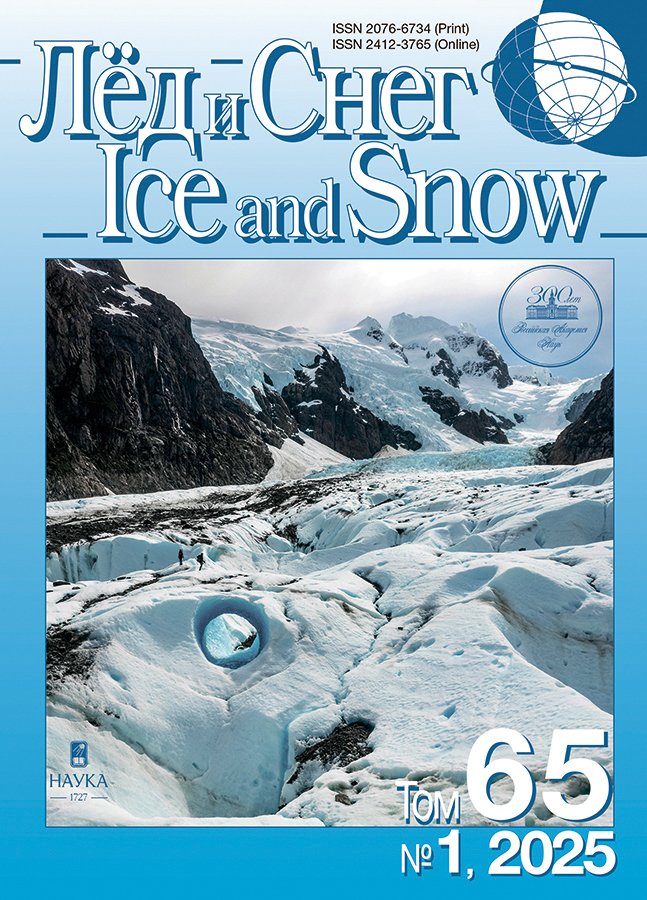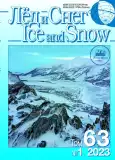Estimates of the Statistical Correlation Between the Extreme Ice Pressure Patterns with Various Spatial Resolution
- Authors: Klyachkin S.V.1
-
Affiliations:
- Arctic and Antarctic Research Institute
- Issue: Vol 63, No 1 (2023)
- Pages: 116-129
- Section: Sea, river and lake ices
- URL: https://journals.rcsi.science/2076-6734/article/view/137482
- DOI: https://doi.org/10.31857/S2076673423010088
- EDN: https://elibrary.ru/MABIRX
- ID: 137482
Cite item
Full Text
Abstract
Ice pressure is characterized with significant spatial variability. Study of this variability with the help of in situ observations is rather difficult, because (1) the instrumental measurements are expensive and technically complicated, and, hence, the amount of such measurements is little, and (2) the visual observations have predominantly qualitative character and depend significantly on the observer’s experience. The most widely used method of obtaining the ice pressure information is model simulations. The existing ice dynamics models allow simulating the ice pressure averaged within the area of the model grid cell, which usually has the spatial size varying from 5 to 25 km, sometimes - up to 50 km. It is clear that such spatial resolution does not give the picture of local peaks of ice pressure with spatial scale much less that the size of the grid cell. The aim of the presented paper is, basing on the model results with spatial resolution from 5 to 50 km, to study the statistical correlations between the ice pressure fields with various spatial resolutions, and to evaluate the possibility of calculating the intensity and probability of ice pressure peaks with spatial scale less than the spatial resolution of the model. In order to solve this problem, the numerical dynamic-thermodynamic model of ice cover evolution developed both for the entire Arctic Ocean and for large regions (the Barents and Kara Seas), and, for more detailed spatial resolution, for some smaller basins (the Pechora Sea, the south-western Kara Sea, the Baidara Bay), was used. The ice pressure fields within the same region and the same period of time were simulated with various spatial resolutions – from 5 to 50 km. The initial ice conditions were stated with the help the AARI ice charts which cover both the entire Arctic Ocean and the specific regions mentioned above. The comparison of model results with various spatial resolutions allowed revealing moderate statistical correlation between the average ice pressure obtained from the lower resolution model, and ice pressure dispersion obtained from the higher resolution one (correlation coefficients comprise from 0.3 to 0.7). This correlation is put into base of the main principles of calculating the extreme ice pressure in the spatial scale much less than the spatial resolution of the model. The statistical probability of the extreme ice pressure is strictly connected with the ratio between the spatial resolution of the model and the spatial scale of the extreme ice pressure to be estimated. For example, as the preliminary calculations show, if the spatial resolution of the numerical model equals 50 km, the extreme ice pressure in the scale of 1 km can exceed the mean value by 5–7 times. It gives on opportunity to obtain more comprehensive picture of ice pressure, and, as the method would be developed further, to increase significantly the informative value of the ice pressure forecasts. The limits of applicability of the proposed approach are discussed specifically.
About the authors
S. V. Klyachkin
Arctic and Antarctic Research Institute
Email: svkl@aari.ru
Russia, St. Petersburg
References
- Appel I.L., Gudkovich Z.M. Chislennoye modelirovaniye i prognoz evolutsii ledyanogo pokrova arkticheskikh morei v period tayaniya. Numerical modeling and forecast of the ice cover evolution of the Arctic seas in melting period. St. Petersburg: Hydrometeoizdat, 1992: 143 p. [In Russian].
- Voyevodin V.A. Vetroviye szhatiya morskikh ldov i ikh vliyaniye na sudokhodstvo. Wind-caused ice pressure and its effect on navigation. PhD. Leningrad: AARI, 1978: 212 p. [In Russian].
- Gavrilo V.P. Mechanical properties of sea ice. Terminology, experimental characteristics. In: Morskoy led. Sea ice. St. Petersburg: Hydrometeoizdat, 1997: 126–171 [In Russian].
- Gudkovich Z.M., Doronin Yu.P. Dreif morskikh l’dov. Sea ice drift. St. Petersburg: Hydrometeoizdat, 2001: 112 p. [In Russian].
- Gumbel E. Statistika ekstremalnykh znacheniy. Statistics of extremes. Moscow: Mir, 1965: 586 p. [In Russian].
- Klyachkin S.V., Gudkovich Z.M., May R.I., Frolov S.V. Ice pressure. Opasniye ledoviye yavleniya dlya sudokhodstva v Arktike. Ice phenomena threating Arctic shipping. Edited by Ye.U. Mironov. St. Petersburg: AARI, 2010. 33–91 [In Russian]
- Klyachkin S.V., Guzenko R.B., May R.I. Numerical model of the ice cover evolution in Arctic Seas for the operational forecasting. Led i Sneg. Ice and Snow. 2015, 55 (3): 83–96 [In Russian]. https://doi.org/10.15356/2076-6734-2015-3-83-96
- Klyachkin S.V., Guzenko R.B., May R.I. Statistical features of sea ice drift extremes in the south-western Kara Sea from the results of numerical modelling. Problemy Arktiki i Antarktiki. Problems of Arctic and Antarctic. 2020, 66 (4): 427–445 [In Russian]. https://doi.org/10.30758/0555-2648-2020-66-4-427-445
- Nikolayeva A.Ya., Shesterikov N.P. Method of calculating the ice conditions (on the example of the Laptev Sea). Trudy AANII. Proc. AARI. 1970, 292: 143–217 [In Russian].
- Kheisin D.Ye., Ivchenko V.O. Propagation of ice pressure in close ice. Okeanologiya. Oceanography. 1975, 15 (5): 803–812 [In Russian].
- Lemieux J.-F., Tremblay B., Plante M. Toward a method for downscaling sea ice pressure for navigation purposes // The Cryosphere. 2020, 14: 3465–2020. https://doi.org/10.5194/tc-14-3465-2020/
- Leppäranta M. The drift of sea ice. Heidelberg. Germany. Springer-Praxis, 2005: 282 p.
- Richter-Menge J.A., Elder B.C. Characteristics of pack ice stress in the Alaskan Beaufort Sea // Journ. of Geophys. Research. 1998, 103 (C10): 21817–21829.
- Richter-Menge J.A., McNutt S.L. Overland J.E., Kwok R. Relating arctic pack ice stress and deformation under winter conditions // Journ. of Geophys. Research. 2002, 107 (C10): 8040. https://doi.org/10.1029/2000JC000477
- Tucker W.B. III., Perovich D.K., Hopkins M.A., Hibler III W.D. On the relationship between local stresss and strains in Arctic pack ice // Annals of Glaciology. 1991, 15: 265–270.
- Tucker W.B. III., Perovich D.K. Stress measurements in drifting pack ice // Cold Region Science and Technology. 1992, 20 (2): 119–139. https://doi.org/10.1016/0165-232X(92)90012-J
Supplementary files














